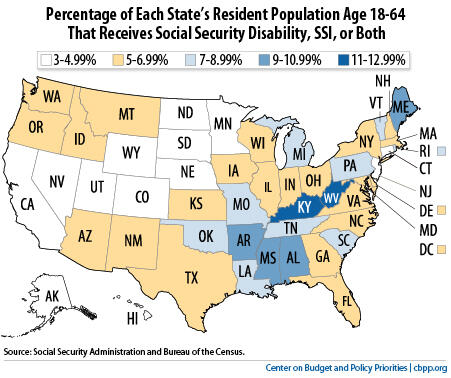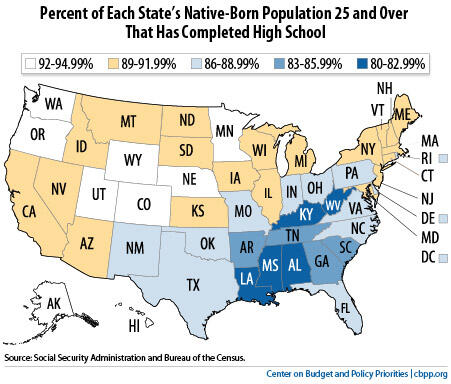BEYOND THE NUMBERS
About 6 percent of the nation’s working-age population receive disability payments from Social Security or Supplemental Security Income (SSI), but some southern and Appalachian states have much higher rates —over 10 percent. While some critics see this disparity as evidence of problems with the programs, it mostly reflects a few key demographic and economic factors:
- Less-educated workforce. This is by far the most powerful factor: states with low rates of high-school completion generally have high rates of disability receipt, as you can see by comparing the two maps below. For older workers, SSI and Social Security disability insurance explicitly consider vocational and educational factors in determining eligibility, since less-educated people whose physical or mental impairment is so severe that they can’t do their previous work are less able to adapt to other employment than better-educated people are.


- Older workforce. The risk of disability rises sharply with age. The typical disability insurance beneficiary is in late middle age — 70 percent are over age 50, and 30 percent are 60 or older. New England and Appalachia have a higher median age than most of the rest of the country, which boosts their rates of disability receipt compared with the “young” Southwest and West.
- Fewer immigrants. Immigrants, especially recent arrivals, are far less likely than native-born citizens to collect disability benefits. States with large foreign-born populations — notably California, New Jersey, Nevada, New York, Florida, and Texas — have fewer disability recipients than you’d expect based solely on their age and educational characteristics.
- Industry-based economy. States where much of the workforce is employed in forestry, mining, and manufacturing — such as the industrial Midwest and many southern and Appalachian states — tend to have more disability recipients than states with more service-oriented economies, all else being equal. Such jobs are often physically demanding and involve skills that don’t transfer readily to other forms of work — two factors that the programs’ eligibility rules for older applicants take into account.
Other factors have weaker effects. Poverty rates help to explain participation in SSI (which is means-tested) but have less bearing on Social Security disability (which isn’t). Unemployment rates explain little of the geographic variation. Although higher unemployment boosts disability applications, researchers conclude that those extra applicants are also more likely to be denied.
Disability is a personal tragedy and economic hardship for workers and their families. We should strive to aid these workers through job accommodations (such as special equipment to help them perform their job), universal health insurance, and rehabilitation opportunities — while also recognizing that Social Security disability insurance and SSI are a vital part of our nation’s safety net.
